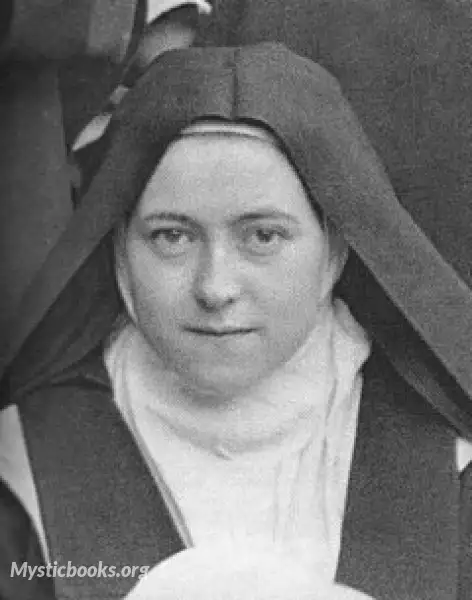
Timeline
Title
Country/Nationality
Saint Therese
Thérèse of Lisieux also known as Saint Therese of the Child Jesus and the Holy Face (Thérèse de l’Enfant Jésus et de la Sainte Face), was a French Catholic Discalced Carmelite nun who is widely venerated in modern times. She is popularly known in English as "The Little Flower of Jesus", or simply "The Little Flower,” and in French as la petite Thérèse (little Thérèse).
Therese has been a highly influential model of sanctity for Catholics and for others because of the simplicity and practicality of her approach to the spiritual life. Together with Francis of Assisi, she is one of the most popular saints in the history of the church. Pope Pius X called her "the greatest saint of modern times".
Therese felt an early call to religious life and after overcoming various obstacles in 1888, at the early age of 15, she became a nun and joined two of her older sisters in the cloistered Carmelite community of Lisieux, Normandy (yet another sister, Céline, also later joined the order). After nine years as a Carmelite religious, having fulfilled various offices such as sacristan and assistant to the novice mistress, in her last eighteen months in Carmel she fell into a night of faith, in which she is said to have felt Jesus was absent and been tormented by doubts that God existed. Therese died at the age of 24 from tuberculosis.
Her feast day in the General Roman Calendar was 3 October from 1927 until it was moved in 1969 to 1 October. Therese is well known throughout the world, with the Basilica of Lisieux being the second most popular place of pilgrimage in France after Lourdes.
Therese was born on Rue Saint-Blaise, in Alençon, France on January 2, 1873, and was the daughter of Marie-Azélie Guérin (usually called Zélie), and Louis Martin who was a jeweler and watchmaker . Both her parents were devout Catholics who would eventually become the first (and to date only) married couple canonized together by the Roman Catholic Church (by Pope Francis in 2015).
Louis had tried to become a canon regular, wanting to enter the Great St Bernard Hospice, but had been refused because he knew no Latin. Zélie, possessed of a strong, active temperament, wished to serve the sick, and had also considered entering consecrated life, but the prioress of the canonesses regular of the Hôtel-Dieu in Alençon had discouraged her outright. Disappointed, Zélie learned lacemaking instead. She excelled in it and set up her own business on Rue Saint-Blaise at age 22.
On 2 April 1874, when she was 15 months old, she returned to Alençon where her family surrounded her with affection. "I hear the baby calling me Mama! as she goes down the stairs. On every step, she calls out Mama! and if I don't respond every time, she remains there without going either forward or back." (Madame Martin to Pauline, 21 November 1875) She was educated in a very Catholic environment, including Mass attendance at 5:30 a.m., the strict observance of fasts, and prayer to the rhythm of the liturgical year. The Martins also practiced charity, visiting the sick and elderly and welcoming the occasional vagabond to their table. Even if she was not the model little girl, her sisters later portrayed, Therese was very responsive to this education. She played at being a nun. Described as generally a happy child, she also manifested other emotions, and often cried: "Céline is playing with the little one with some bricks … I have to correct poor baby who gets into frightful tantrums when she can't have her own way. She rolls in the floor in despair believing all is lost. Sometimes she is so overcome she almost chokes. She's a nervous child, but she is very good, very intelligent, and remembers everything." At 22, Therese, then a Carmelite, admitted: "I was far from being a perfect little girl".
Therese's final years were marked by a steady decline that she bore resolutely and without complaint. Tuberculosis was the key element of Therese's final suffering, but she saw that as part of her spiritual journey. After observing a rigorous Lenten fast in 1896, she went to bed on the eve of Good Friday and felt a joyous sensation. She wrote: "Oh! how sweet this memory really is! … I had scarcely laid my head upon the pillow when I felt something like a bubbling stream mounting to my lips. I didn't know what it was." The next morning her handkerchief was soaked in blood and she understood her fate. Coughing up of blood meant tuberculosis, and tuberculosis meant death. She wrote, "I thought immediately of the joyful thing that I had to learn, so I went over to the window. I was able to see that I was not mistaken. Ah! my soul was filled with a great consolation; I was interiorly persuaded that Jesus, on the anniversary of His own death, wanted to have me hear His first call!"
Therese corresponded with a Carmelite mission in what was then French Indochina and was invited to join them, but, because of her sickness, could not travel. Tuberculosis slowly devoured her flesh. When she was near death, "Her physical suffering kept increasing so that even the doctor himself was driven to exclaim, "Ah! If you only knew what this young nun was suffering!" During the last hours of Therese's life, she said, "I would never have believed it was possible to suffer so much, never, never!" In July 1897, she made a final move to the monastery infirmary. On August 19, 1897, she received her last communion. She died on 30 September 1897, aged 24. On her death-bed, she is reported to have said, "I have reached the point of not being able to suffer any more, because all suffering is sweet to me." Her last words were, "My God, I love you!"
Therese was buried on 4 October 1897, in the Carmelite plot, in the municipal cemetery at Lisieux, where her parents had been buried. Her body was exhumed in September 1910 and the remains placed in a lead coffin and transferred to another tomb. In March 1923, however, before she was beatified, her body was returned to the Carmel of Lisieux, where it remains. The figure of Therese in the glass coffin is not her actual body but a gisant statue based on drawings and photos by Céline after Therese's death. It contains her ribcage and other remnants of her body.
Books by Saint Therese

The Story of a Soul
Marie Francoise Therese Martin, affectionately known as 'The Little Flower', was born on January 2, 1873, in Alencon, France to Louis Martin and Zelie Guerin. She was the youngest and one of five surviving sisters of the nine Martin children. When Th...